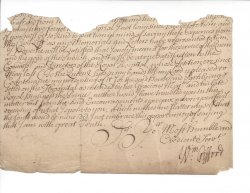
[Sir William Gifford, Governor of Greenwich Hospital.] Conclusion of Autograph Letter Signed ('Wm: Gifford'), regarding a petition to the Queen from 'the Commissrs: and Directors of the Royal Hospital', and raising of funds for the 'House and Park'
On one side of a piece of laid paper, top half torn off and missing, leaving the conclusion of the letter. Roughly 11 x 17.5 cm. Thirteen full lines of text, with two partial lines along the tear at the top edge. A frail item, in fair condition, aged and worn. See Gifford's entry in the History of Parliament. The letter, apparently addressed to an individual at the Admiralty or the Treasury, concerns a part of the tortuous process of raising finances for the conversion of the Queen's House into the hospital. It reads: '[…] have forgot [the Mem]orial I not long since laid before him, and if you will be so kind to put him in mind of saving these expences from the Civil List as my Memorials and Letters have represented to him, I hope he will be satisfied that I onely mean it for the service of the Queen and the good of the Publick, and it will be a true satisfaction to the Commissrs: and Directors of the Royal Hospital, whose Petition e're since May last (To the Queen) lyes in my hands 'till my Lord is pleased to Countenance my presenting of it for the said House and Park being setled on the Hospital as intended by her Gracious Majtie: and his late Royal Highness the Prince, neither wou'd I have troubled you in this matter but from the kind Encouragements you gave me on your Civil receiving of what I spoke to you, which makes me flatter myself that the fault wou'd be mine did I not embrace this opportunity of saying that I am with great Truth, | Sir, Yor. Most humble and | Obedient Servt: | Wm: Gifford'. Note:"The other principal buildings constructed included Queen Mary Court (planned by Wren and Hawksmoor, but not built until after Wren's death, by Thomas Ripley), completed in 1742, Queen Anne Court (architects: Wren and Hawksmoor), and King William Court (designed by Wren, but completed by Hawksmoor and Sir John Vanbrugh)."


